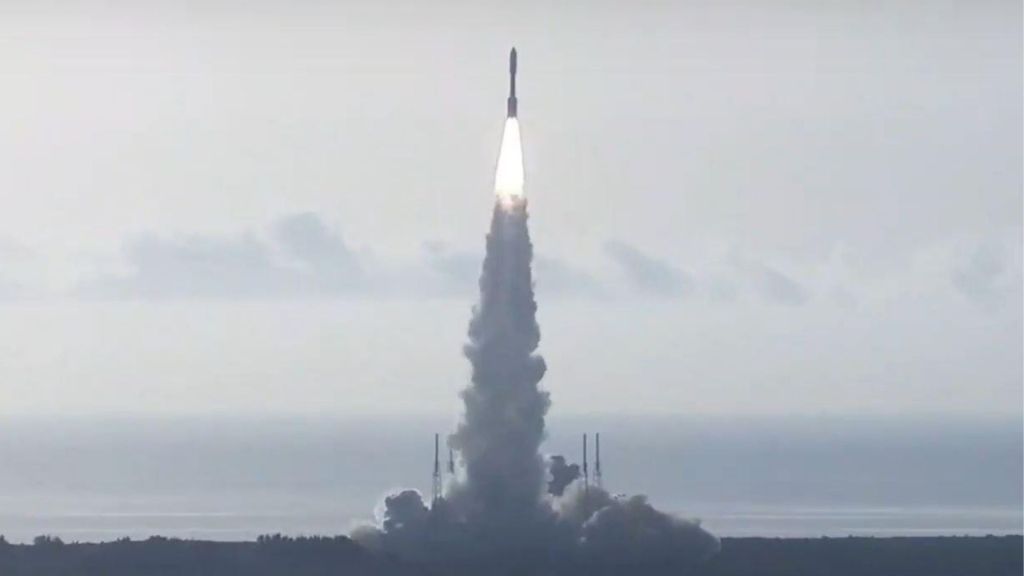NASA’s newest Mars rover, Perseverance, is officially on its way to the red planet after a successful launch from Cape Canaveral, Florida, on Thursday morning.
Weighing in at about 2,260 pounds, Perseverance is the largest and most advanced rover that has ever been sent to Mars, and is tasked with looking for signs of life on the Martian surface. The rover is scheduled to touch down in Jezero Crater, an impact basin that was once filled with water billions of years ago, on February 18, 2021.
Videos by VICE
In addition to driving across this tantalizing dried-up lakebed, Perseverance will deploy a drone helicopter called Ingenuity for short test flights, which will mark the first time that an aerial vehicle has been flown on another planet. The rover will also drill out 2.4-inch deep samples of the Martian terrain and cache them in preparation for a future mission that will pick them up and send them back to Earth.
Perseverance blasted off on an Atlas V rocket at 7:50 a.m. from Launch Complex 41 at Cape Canaveral Air Force Station. It is the last of three Mars-bound spacecraft to depart the Earth this month, and is preceded by the Hope orbiter from the United Arab Emirates and China’s Tianwen-1 mission, which includes a rover and a lander. These missions were all launched within weeks of each other to take advantage of the best transfer orbit to Mars, which becomes available every two years.
Perseverance follows on the success of NASA’s Curiosity rover, which landed in Mars’ Gale Crater in August 2012 and is still roaming the Martian surface eight years later.
Because Curiosity has been such a boon for planetary scientists—the rover found that the red planet once had the right ingredients for life, among other discoveries—Perseverance is basically a beefed-up version of its predecessor with some next-generation technologies. The new rover will also emulate Curiosity’s high-stakes landing sequence, nicknamed the “seven minutes of terror,” which involves a robust heat shield, supersonic parachutes, and a complicated sky-crane that will lower the rover to the surface.
Perseverance is equipped with a suite of seven types of scientific instruments, including 23 cameras and two microphones, that will help it explore and assess its surroundings in Jezero Crater. Its Mastcam-Z will have a zoom function that will help the rover orient itself, while its SuperCam can snap images as well as conduct chemical and mineralogical analysis of the Martian landscape.
The Planetary Instrument for X-ray Lithochemistry (PIXL) and Scanning Habitable Environments with Raman & Luminescence for Organics and Chemicals (SHERLOC) are both spectrometers that will parse elemental compositions of Jezero Crater with high precision. The environmental conditions of the landing site, such as weather patterns, will be monitored by the Mars Environmental Dynamics Analyzer (MEDA), and the Radar Imager for Mars’ Subsurface Experiment (RIMFAX) will probe the subsurface of Mars with radar.
The rover will also test out a novel instrument called the Mars Oxygen ISRU Experiment (MOXIE) that is designed to spin oxygen out of carbon dioxide, which is the most abundant gas in the Martian atmosphere. This experiment is a testbed for life support systems that will require breathable oxygen for future human missions to Mars.
Perseverance also carries a drill that it will use to extract about 30 samples from Jezero Crater that can be picked up by a future sample-return mission. The samples will be about 0.5 inches in diameter and 2.4 inches in depth and will remain hermetically sealed in tubes in the rover’s belly until mission leads decide on a cache site for an “easy” (relatively speaking) pickup sometime in the coming decades.
The new rover has a projected mission duration of one Martian year, which is equal to about 687 Earth days. However, NASA’s past rovers—including Curiosity and the twins Opportunity and Spirit—all outlasted their expected durations, so Perseverance may end up living up to its name if it follows the extended lifespans of its forebears.
More
From VICE
-

Photo: Getty Images -

Photo: Anton Petrus / Getty Images -

Huge new game reveals at the 2025 Game Awards

